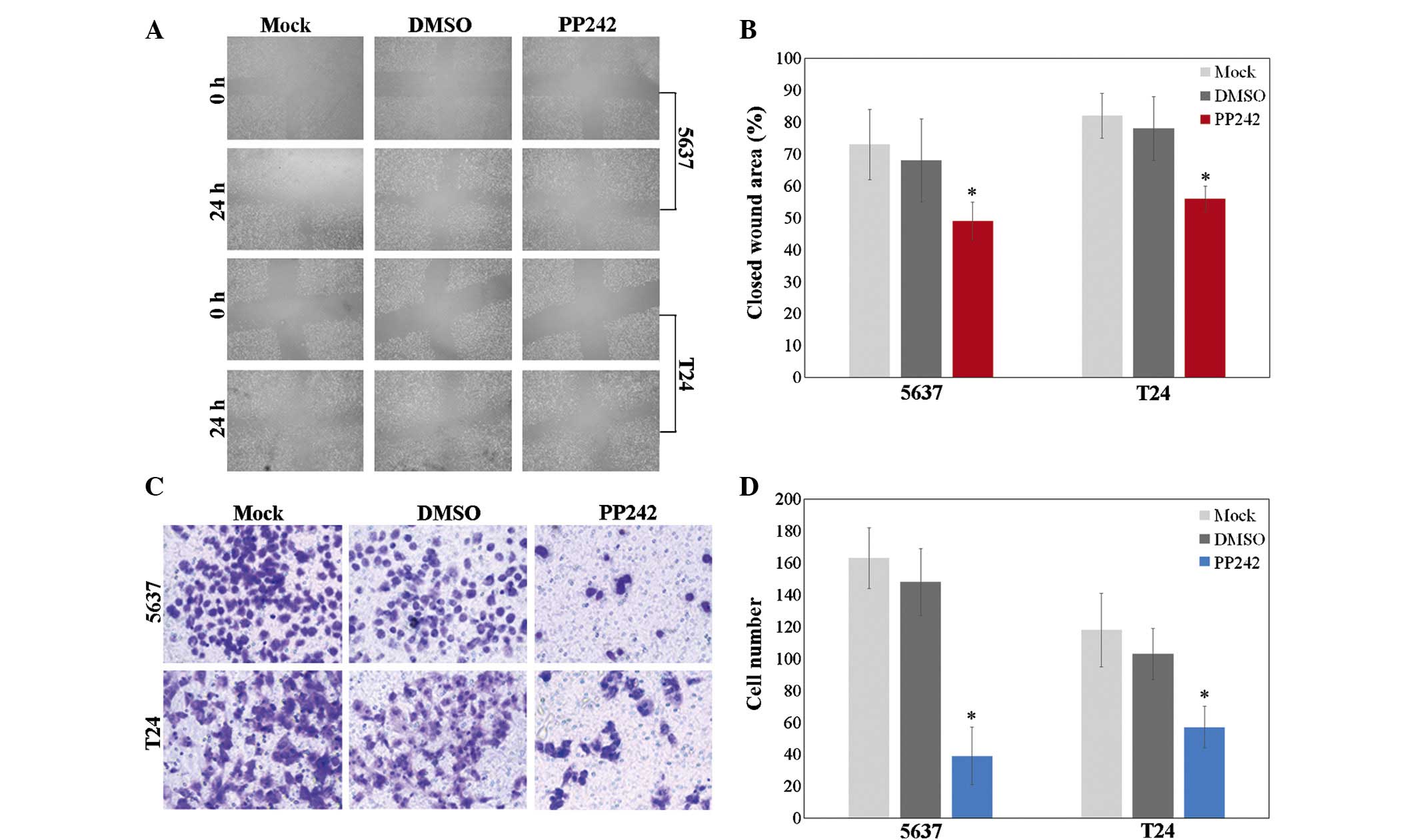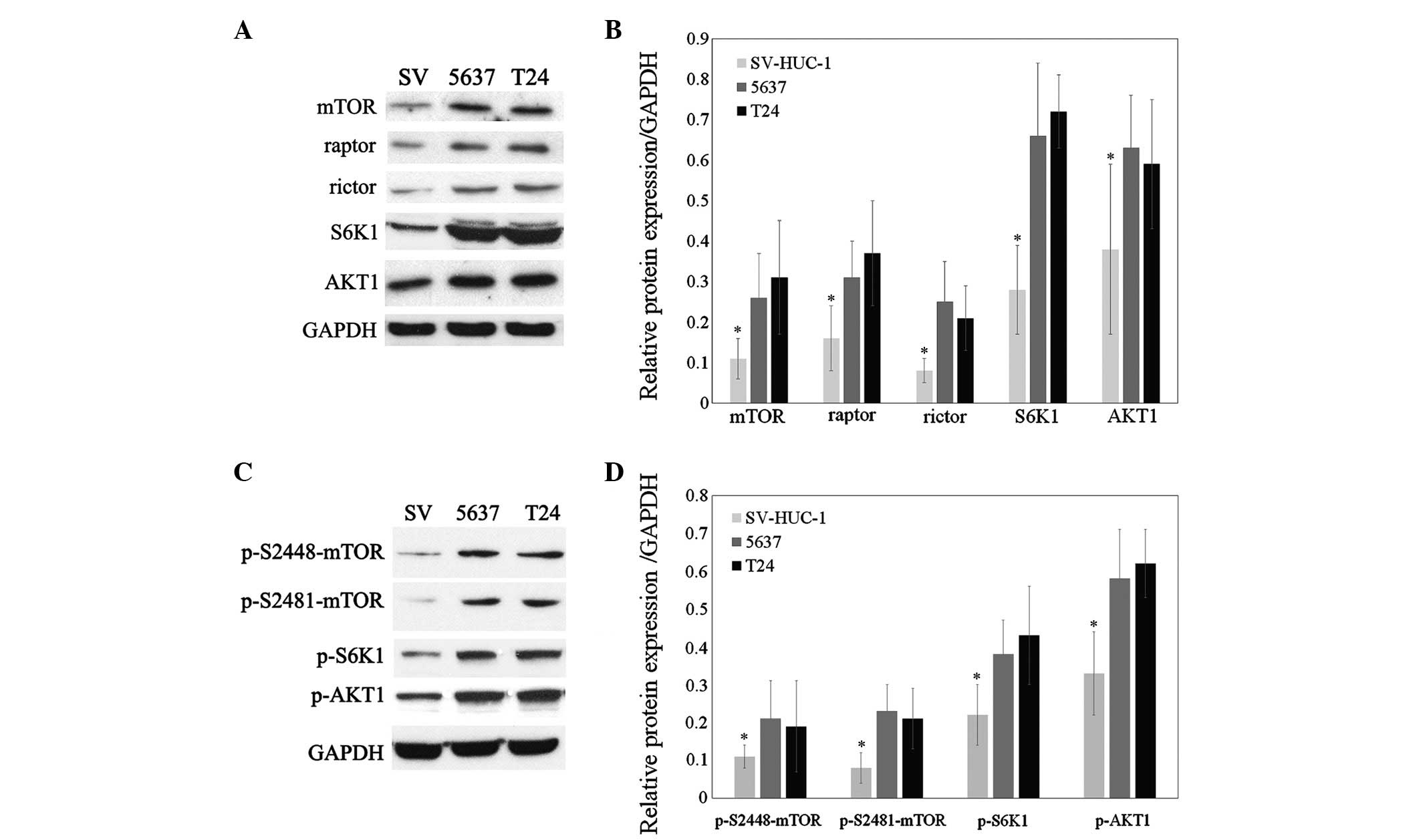|
1
|
Zuo W, Wang ZZ and Xue J: Artesunate
induces apoptosis of bladder cancer cells by miR-16 regulation of
COX-2 expression. Int J Mol Sci. 15:14298–14312. 2014. View Article : Google Scholar : PubMed/NCBI
|
|
2
|
Chang H, Peng X, Bai Q, Zhou Y, Yu X,
Zhang Q, Zhu J and Mi M: Ampelopsin suppresses breast
carcinogenesis by inhibiting the mTOR signaling pathway.
Carcinogenesis. 35:1847–1854. 2014. View Article : Google Scholar : PubMed/NCBI
|
|
3
|
Rivas DA, Yaspelkis BB III, Hawley JA and
Lessard SJ: Lipid-induced mTOR activation in rat skeletal muscle
reversed by exercise and 5′-aminoimidazole-4-carboxamide-1-beta
-D-ribofuranoside. J Endocrinol. 202:441–451. 2009. View Article : Google Scholar : PubMed/NCBI
|
|
4
|
Wahane SD, Hellbach N, Prentzell MT, Weise
SC, Vezzali R, Kreutz C, Timmer J, Krieglstein K, Thedieck K and
Vogel T: PI3K-p110-alpha-subtype signalling mediates survival,
proliferation and neurogenesis of cortical progenitor cells via
activation of mTORC2. J Neurochem. 130:255–267. 2014. View Article : Google Scholar : PubMed/NCBI
|
|
5
|
Zhang Z, Zhang G, Xu X, Su W and Yu B:
MTOR-rictor is the Ser473 kinase for AKT1 in mouse one-cell stage
embryos. Mol Cell Biochem. 361:249–257. 2012. View Article : Google Scholar
|
|
6
|
Jash S, Dhar G, Ghosh U and Adhya S: Role
of the mTORC1 complex in satellite cell activation by RNA-induced
mitochondrial restoration: Dual control of cyclin D1 through
microRNAs. Mol Cell Biol. 34:3594–3606. 2014. View Article : Google Scholar : PubMed/NCBI
|
|
7
|
Goodman CA: The role of mTORC1 in
regulating protein synthesis and skeletal muscle mass in response
to various mechanical stimuli. Rev Physiol Biochem Pharmacol.
166:43–95. 2014.PubMed/NCBI
|
|
8
|
Faller WJ, Jackson TJ, Knight JR, Ridgway
RA, Jamieson T, Karim SA, Jones C, Radulescu S, Huels DJ, Myant KB,
et al: MTORC1-mediated translational elongation limits intestinal
tumour initiation and growth. Nature. 517:497–500. 2015. View Article : Google Scholar :
|
|
9
|
Kaibori M, Shikata N, Sakaguchi T,
Ishizaki M, Matsui K, Iida H, Tanaka Y, Miki H, Nakatake R, Okumura
T, et al: Influence of rictor and raptor expression of mtor
signaling on long-term outcomes of patients with hepatocellular
carcinoma. Dig Dis Sci. 60:919–928. 2015. View Article : Google Scholar
|
|
10
|
Randall JM, Millard F and Kurzrock R:
Molecular aberrations, targeted therapy and renal cell carcinoma:
Current state-of-the-art. Cancer Metastasis Rev. 33:1109–1124.
2014. View Article : Google Scholar : PubMed/NCBI
|
|
11
|
Treilleux I, Arnedos M, Cropet C, Wang Q,
Ferrero JM, Abadie-Lacourtoisie S, Levy C, Legouffe E, Lortholary
A, Pujade-Lauraine E, et al: Translational studies within the
TAMRAD randomized GINECO trial: Evidence for mTORC1 activation
marker as a predictive factor for everolimus efficacy in advanced
breast cancer. Ann Oncol. 26:120–125. 2015. View Article : Google Scholar
|
|
12
|
Sandhöfer N, Metzeler KH, Rothenberg M,
Herold T, Tiedt S, Groiß V, Carlet M, Walter G, Hinrichsen T,
Wachter O, et al: Dual PI3 K/mTOR inhibition shows antileukemic
activity in MLL rearranged acute myeloid leukemia. Leukemia.
29:828–838. 2015. View Article : Google Scholar
|
|
13
|
Yue H, Li W, Liu P, Gao J, Miao J and Zhao
J: Inhibition of autophagy promoted sphingosylphosphorylcholine
induced cell death in non-small cell lung cancer cells. Biochem
Biophys Res Commun. 453:502–507. 2014. View Article : Google Scholar : PubMed/NCBI
|
|
14
|
Joha S, Nugues AL, Hétuin D, Berthon C,
Dezitter X, Dauphin V, Mahon FX, Roche-Lestienne C, Preudhomme C,
Quesnel B and Idziorek T: GILZ inhibits the mTORC2/AKT pathway in
BCR-ABL(+) cells. Oncogene. 31:1419–1430. 2012. View Article : Google Scholar :
|
|
15
|
Zheng X, Liang Y, He Q, Yao R, Bao W, Bao
L, Wang Y and Wang Z: Current models of mammalian target of
rapamycin complex 1 (mTORC1) activation by growth factors and amino
acids. Int J Mol Sci. 15:20753–20769. 2014. View Article : Google Scholar : PubMed/NCBI
|
|
16
|
Huang Y, Xi Q, Chen Y, Wang J, Peng P, Xia
S and Yu S: A dual mTORC1 and mTORC2 inhibitor shows antitumor
activity in esophageal squamous cell carcinoma cells and sensitizes
them to cisplatin. Anticancer Drugs. 24:889–898. 2013. View Article : Google Scholar : PubMed/NCBI
|
|
17
|
Zhang Z, Zhang G and Kong C: High
expression of Cdc25B and low expression of 14-3-3σ is associated
with the development and poor prognosis in urothelial carcinoma of
bladder. Tumour Biol. 35:2503–2512. 2014. View Article : Google Scholar
|
|
18
|
Fan W, Cheng K, Qin X, Narsinh KH, Wang S,
Hu S, Wang Y, Chen Y, Wu JC, Xiong L and Cao F: MTORC1 and mTORC2
play different roles in the functional survival of transplanted
adipose-derived stromal cells in hind limb ischemic mice via
regulating inflammation in vivo. Stem Cells. 31:203–214. 2013.
View Article : Google Scholar
|
|
19
|
Baack Kukreja JE, Scosynev E, Brasachio
RA, Toy EP, Messing EM and Wu G: Bladder cancer incidence and
mortality in patients treated with radiation for uterine cancer.
BJU Int. 114:844–851. 2014. View Article : Google Scholar
|
|
20
|
Kamat AM, Vlahou A, Taylor JA, Hudson ML,
Pesch B, Ingersoll MA, Todenhöfer T, van Rhijn B, Kassouf W, Barton
Grossman H, et al: Considerations on the use of urine markers in
the management of patients with high-grade non-muscle-invasive
bladder cancer. Urol Oncol. 32:1069–1077. 2014. View Article : Google Scholar : PubMed/NCBI
|
|
21
|
Petrelli F, Coinu A, Cabiddu M, Ghilardi
M, Vavassori I and Barni S: Correlation of pathologic complete
response with survival after neoadjuvant chemotherapy in bladder
cancer treated with cystectomy: A meta-analysis. Eur Urol.
65:350–357. 2014. View Article : Google Scholar
|
|
22
|
Xing X, Zhang L, Wen X, Wang X, Cheng X,
Du H, Hu Y, Li L, Dong B, Li Z and Ji J: PP242 suppresses cell
proliferation, metastasis and angiogenesis of gastric cancer
through inhibition of the PI3K/AKT/mTOR pathway. Anticancer Drugs.
25:1129–1140. 2014. View Article : Google Scholar : PubMed/NCBI
|
|
23
|
Korets SB, Musa F, Curtin J, Blank SV and
Schneider RJ: Dual mTORC1/2 inhibition in a preclinical xenograft
tumor model of endometrial cancer. Gynecol Oncol. 132:468–473.
2014. View Article : Google Scholar
|
|
24
|
Zhou HY and Huang SL: Current development
of the second generation of mTOR inhibitors as anticancer agents.
Chin J Cancer. 31:8–18. 2012.
|
|
25
|
Chen L, Xu B, Liu L, Liu C, Luo Y, Chen X,
Barzegar M, Chung J and Huang S: Both mTORC1 and mTORC2 are
involved in the regulation of cell adhesion. Oncotarget.
30:7136–7150. 2015. View Article : Google Scholar
|
|
26
|
Ravichandran K, Zafar I, Ozkok A and
Edelstein CL: An mTOR kinase inhibitor slows disease progression in
a rat model of poly-cystic kidney disease. Nephrol Dial Transplant.
30:45–53. 2015. View Article : Google Scholar
|
|
27
|
Qin Y, Zhao X and Fang Y: PP242 synergizes
with suberoylanilide hydroxamic acid to inhibit growth of ovarian
cancer cells. Int J Gynecol Cancer. 24:1373–1380. 2014. View Article : Google Scholar : PubMed/NCBI
|
|
28
|
Goncharov DA, Kudryashova TV, Ziai H,
Ihida-Stansbury K, DeLisser H, Krymskaya VP, Tuder RM, Kawut SM and
Goncharova EA: Mammalian target of rapamycin complex 2 (mTORC2)
coordinates pulmonary artery smooth muscle cell metabolism,
proliferation and survival in pulmonary arterial hypertension.
Circulation. 129:864–874. 2014. View Article : Google Scholar :
|
|
29
|
Becker MN, Wu KJ, Marlow LA, Kreinest PA,
Vonroemeling CA, Copland JA and Williams CR: The combination of an
mTORc1/TORc2 inhibitor with lapatinib is synergistic in bladder
cancer in vitro. Urol Oncol. 32:317–326. 2014. View Article : Google Scholar
|
|
30
|
Bogani C, Bartalucci N, Martinelli S,
Tozzi L, Guglielmelli P, Bosi A and Vannucchi AM; Associazione
Italiana per la Ricerca sul Cancro AGIMM Gruppo Italiano Malattie
Mieloproliferative: MTOR inhibitors alone and in combination with
JAK2 inhibitors effectively inhibit cells of myeloproliferative
neoplasms. PLoS One. 8:e548262013. View Article : Google Scholar : PubMed/NCBI
|
|
31
|
Müller J, Ehlers A, Burkhardt L, Sirma H,
Steuber T, Graefen M, Sauter G, Minner S, Simon R, Schlomm T and
Michl U: Loss of pSer2448-mTOR expression is linked to adverse
prognosis and tumor progression in ERG-fusion-positive cancers. Int
J Cancer. 132:1333–1340. 2013. View Article : Google Scholar
|
|
32
|
Vazquez-Martin A, Oliveras-Ferraros C,
Bernadó L, López-Bonet E and Menendez JA: The serine
2481-autophos-phorylated form of mammalian Target of Rapamycin
(mTOR) is localized to midzone and midbody in dividing cancer
cells. Biochem Biophys Res Commun. 380:638–643. 2009. View Article : Google Scholar : PubMed/NCBI
|
|
33
|
Wang X, Lai P, Zhang Z, Huang M, Wang L,
Yin M, Jin D, Zhou R and Bai X: Targeted inhibition of mTORC2
prevents osteosarcoma cell migration and promotes apoptosis. Oncol
Rep. 32:382–388. 2014.PubMed/NCBI
|
|
34
|
Li H, Lin J, Wang X, Yao G, Wang L, Zheng
H, Yang C, Jia C, Liu A and Bai X: Targeting of mTORC2 prevents
cell migration and promotes apoptosis in breast cancer. Breast
Cancer Res Treat. 134:1057–1066. 2012. View Article : Google Scholar : PubMed/NCBI
|













